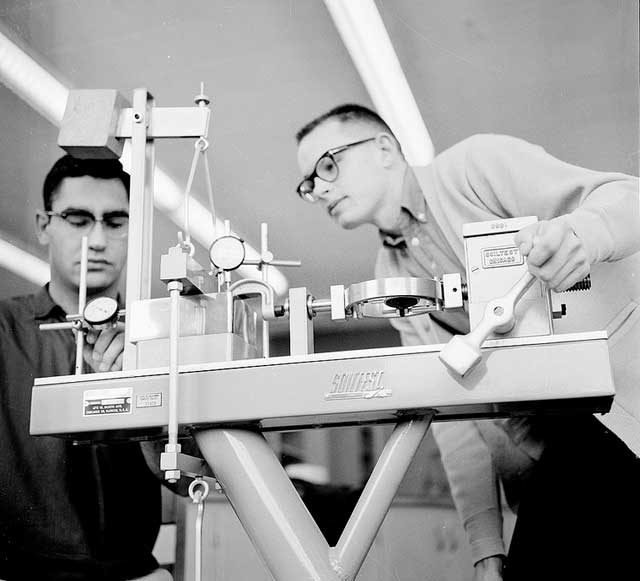
In this 2010 photo, students in Applied Ecological Resortation (ENVS 450) record data on vegetation in the Jolly Giant Creek just behind campus. Student’s earning a minor in environmental restoration from the Department of Environmental Science and Management work throughout the North Coast and state to repair and restore damaged environments.

Students take part in a water ballet course in the old indoor swimming pool in this undated photo. HSU's new swimming pool, which opened in 2008, includes a 25-yard lap pool with an “L” shaped shallow pool. The pool can host as many as 196 swimmers and features extra depth for SCUBA classes.
Physical education has been a part of Humboldt State since the first classes in 1914. The college's original site, austere as it was, included a gymnasium, manual training room, domestic science room and library.
The older structures that make up today's athletics facilities came online between 1959 and 1960. In addition to the indoor swimming pool seen here, '60s-era expansion brought a field house, tennis courts, the men's gym (now East Gym) and a much-needed roof for Redwood Bowl's west stands.

A homecoming queen candidate is paraded through Arcata for the 1955 homecoming festivities. Students elected Fern Flower as their homecoming queen that year. According to HSU history book “A View from the Hill,” homecoming was abandoned on campus in the early ‘70s, but revived by the end of the decade. The 1979 homecoming began a tradition of honoring alumni from Humboldt State’s earliest classes.

A rare snowfall is seen on the track in Redwood Bowl in this photo from the late ‘70s. Snow is an unusual enough event at Humboldt State that publishers of the 1926 yearbook included mention of a snowfall at the Christmas dance (the yearbook also mentions that punch was served). According to the Farmer’s Almanac, Arcata receives exactly zero-inches of snow per year, so traveling winter sports clubs have been active on campus since its earliest days.

In this undated photo, civil engineering students engage in laboratory work at Humboldt State.
Engineering at Humboldt State has had a long evolution since its beginnings in the 1930s. Then, the program incorporated mathematics, surveying and drafting and provided much the same function a junior college pre-engineering program does today.
A 1968 statewide audit of CSU engineering programs almost closed Humboldt's program, but administrators saw a unique opportunity in combining the campus's expertise in natural resources with its civil engineering and engineering science programs.
The program was first dubbed Natural Resources Engineering, then simply Engineering. In 1972 the program was retitled Environmental Resources Engineering. One of the oldest programs of its kind, HSU’s ERE outfit was among the first environmental engineering programs certified by the Accreditation Board for Engineering and Technology.

Since the early 1980s alternative energy engineering has been a part of HSU’s ERE program. Here, students work with fuel cell electrolyzer kits in Intro to Environmental Resources Engineering (ENGR 115) in this 2009 photo.